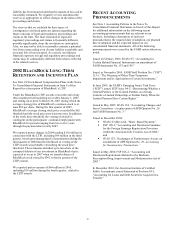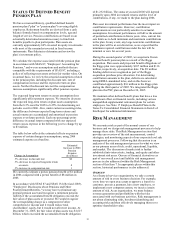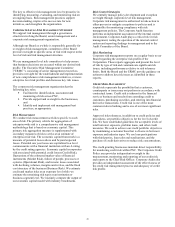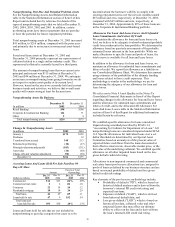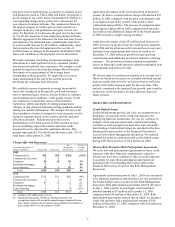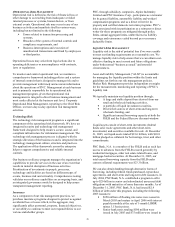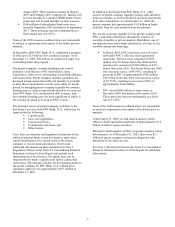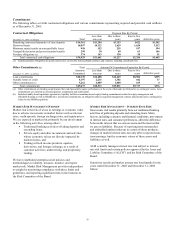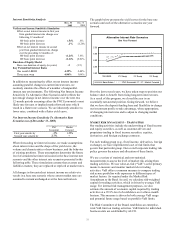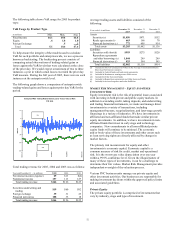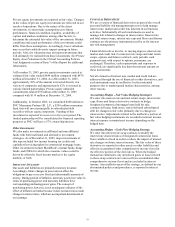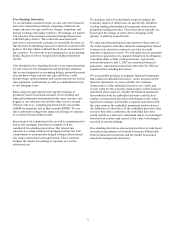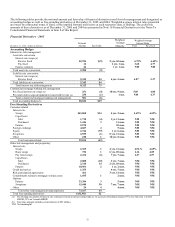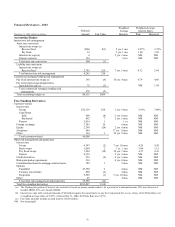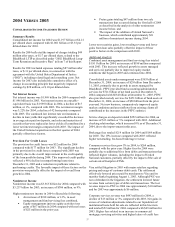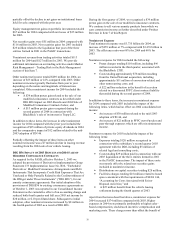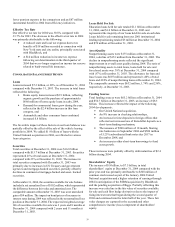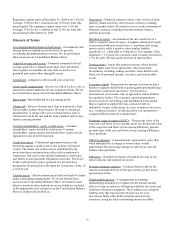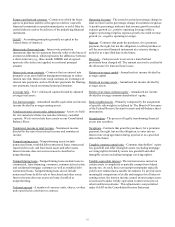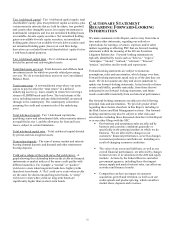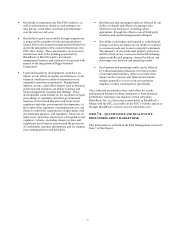PNC Bank 2005 Annual Report Download - page 53
Download and view the complete annual report
Please find page 53 of the 2005 PNC Bank annual report below. You can navigate through the pages in the report by either clicking on the pages listed below, or by using the keyword search tool below to find specific information within the annual report. 53
Private equity investments are reported at fair value. Changes
in the values of private equity investments are reflected in our
results of operations. Due to the nature of the direct
investments, we must make assumptions as to future
performance, financial condition, liquidity, availability of
capital, and market conditions, among other factors, to
determine the estimated fair value of the investments. Market
conditions and actual performance of the investments could
differ from these assumptions. Accordingly, lower valuations
may occur that could adversely impact earnings in future
periods. Also, the valuations may not represent amounts that
will ultimately be realized from these investments. See Private
Equity Asset Valuation in the Critical Accounting Policies
And Judgments section of Item 7 of this Report for additional
information.
At December 31, 2005, private equity investments carried at
estimated fair value totaled $449 million compared with $470
million at December 31, 2004. As of December 31, 2005,
approximately 38% of the amount is invested directly in a
variety of companies and approximately 62% is invested in
various limited partnerships. Private equity unfunded
commitments totaled $78 million at December 31, 2005
compared with $119 million at December 31, 2004.
Additionally, in October 2005, we committed $200 million to
PNC Mezzanine Partners III, L.P., a $350 million mezzanine
fund, that will invest principally in subordinated debt
securities with an equity component. Funding of this
investment is expected to occur over a five-year period. The
limited partnership will be consolidated for financial reporting
purposes as PNC will have a 57% ownership interest.
Other Investments
We also make investments in affiliated and non-affiliated
funds with both traditional and alternative investment
strategies. As of December 31, 2005, major investments of
this type included low income housing tax credits and
capitalized servicing rights for commercial mortgage loans.
Other investments include BlackRock’ s mutual funds, hedge
funds, and CDOs for which the economic values could be
driven by either the fixed-income market or the equity
markets, or both.
IMPACT OF INFLATION
Our assets and liabilities are primarily monetary in nature.
Accordingly, future changes in prices do not affect the
obligations to pay or receive fixed and determinable amounts of
money. During periods of inflation, monetary assets lose value in
terms of purchasing power and monetary liabilities have
corresponding purchasing power gains. The concept of
purchasing power, however, is not an adequate indicator of the
effect of inflation on banks because it does not take into account
changes in interest rates, which are an important determinant of
our earnings.
FINANCIAL DERIVATIVES
We use a variety of financial derivatives as part of the overall
asset and liability risk management process to help manage
interest rate, market and credit risk inherent in our business
activities. Substantially all such instruments are used to
manage risk related to changes in interest rates. Interest rate
and total return swaps, interest rate caps and floors and futures
contracts are the primary instruments used by us for interest
rate risk management.
Financial derivatives involve, to varying degrees, interest rate,
market and credit risk. For interest rate swaps and total return
swaps, options and futures contracts, only periodic cash
payments and, with respect to options, premiums, are
exchanged. Therefore, cash requirements and exposure to
credit risk are significantly less than the notional amount on
these instruments.
Not all elements of interest rate, market and credit risk are
addressed through the use of financial or other derivatives, and
such instruments may be ineffective for their intended
purposes due to unanticipated market characteristics, among
other reasons.
Accounting Hedges - Fair Value Hedging Strategies
We enter into interest rate and total return swaps, interest rate
caps, floors and futures derivative contracts to hedge
designated commercial mortgage loans held for sale,
commercial loans, bank notes, senior debt and subordinated
debt for changes in fair value primarily due to changes in
interest rates. Adjustments related to the ineffective portion of
fair value hedging instruments are recorded in interest income,
interest expense or noninterest income depending on the
hedged item.
Accounting Hedges - Cash Flow Hedging Strategy
We enter into interest rate swap contracts to modify the
interest rate characteristics of designated commercial loans
from variable to fixed in order to reduce the impact of interest
rate changes on future interest income. The fair value of these
derivatives is reported in other assets or other liabilities and
offset in accumulated other comprehensive income (loss) for
the effective portion of the derivatives. When the hedged
transaction culminates, any unrealized gains or losses related
to these swap contracts are removed from accumulated other
comprehensive income (loss) and are included in interest
income. Any ineffectiveness of the strategy, as defined by our
documented policies and procedures, is reported in interest
income.


